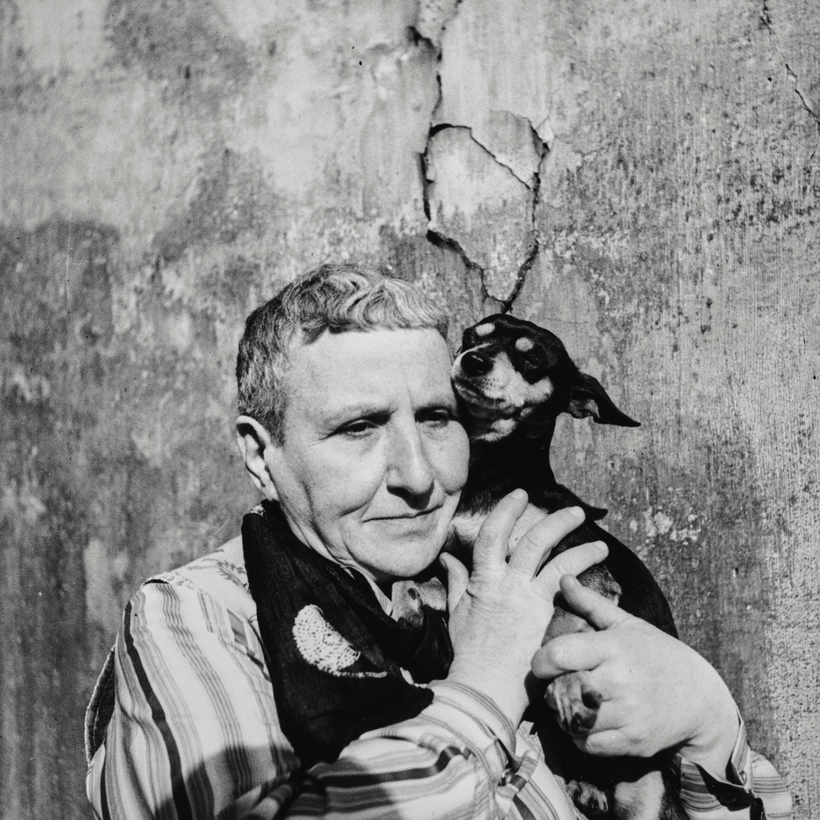I’ve often wished that Gertrude Stein’s art could talk. Those paintings witnessed some of the most storied gatherings in 20th-century avant-garde history: they watched, tacitly, from the grimy white walls of 27 Rue de Fleurus, while Picasso sparred with Matisse over the future of form and color, Hemingway and Fitzgerald brought their latest manuscripts for Stein’s appraisal, and Stein herself—capably guarded by her partner, Alice B. Toklas—wrote the texts that would, as she put it, mark “the first definite step away from the nineteenth century and into the twentieth.”
Only the paintings bore witness to her intense, solitary writing sessions, conducted in the studio by night, Stein flicking the pages of her notebooks with hardly a pause, until dawn birdsong disturbed her concentration. She loved to pose for photographs surrounded by her favorite artworks: a Cézanne portrait of his wife, Hortense, which taught her crucial lessons about the possibilities of shape and space, and Matisse’s Femme au Chapeau, a riot of purples, blues, and pinks that proved so offensive to its first viewers that Matisse considered destroying it for the insurance money, until Stein and her brother Leo made an offer on it. Hung highest of all was Picasso’s famous portrait of her, painted in 1905: “For me, it is I, and it is the only reproduction of me which is always I, for me,” Stein wrote.

Stein’s art collection tells, in its own way, the story of her life. She built it with Leo over a decade living together in Paris, “junking” in antique shops, visiting artists in their studios, and opening up their home to callers who had heard rumors of this private museum of modern art stewarded by eccentric siblings in brown corduroy robes.
In 1913, after a bitter schism, Leo moved out, and the pair divided the art between them. In sole charge, Stein regularly re-arranged the display, consigning works by artists she’d fallen out with to a back room. She sold paintings unsentimentally when she needed money—she gave up a Picasso to fund the publication of her writing when no commercial editor would touch it, and sold Portrait of Madame Cézanne in 1943 to afford food as she waited out the war in the French countryside.

After Stein’s death, in July 1946, Toklas lived on among the paintings—with the exception of the Picasso portrait, which Stein had left to the Metropolitan Museum of Art—until a dispute with Stein’s heirs occasioned the collection’s confiscation. It was later sold; the paintings now live in air-conditioned museums and storage units, perhaps wistful for the days when they sat amid crowds of artists and swirls of cigarette smoke.
Writing about Stein entails reckoning with a wealth of complexities and contradictions. In my years on her trail, I’ve tried to untangle her self-mythologizing, assess her confounding politics, and explore what makes her radical writing so beguiling. And it’s impossible to write about Stein without writing about Toklas, who devoted her life first to enabling Stein’s work, then to shepherding her posthumous legacy with equal zeal, cunning, and devotion.

In the 1950s, Toklas converted to Catholicism, having convinced herself that this would enable her to re-unite with Stein in the afterlife. Since her priest felt uncomfortable taking confession in a room full of paintings of naked women, Toklas fashioned skirts and bodices from cloth and paper and pinned them onto the Picassos.
I was told this story by a veteran Stein scholar, who had heard it from the priest himself. I managed to contact the present owners of one of the offending paintings—Picasso’s Girl with a Basket of Flowers—who confirmed that there are, indeed, some minute pinpricks in the surface of the canvas around the bust area.
History leaves strange, hidden traces. Objects have their own ways of remembering. And works of art, just like artists, achieve their own signature posterity. As one obituary of Stein put it: “Certainly she is not really dead: legends never die.”
Francesca Wade is the author of Square Haunting: Five Writers in London Between the Wars


